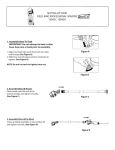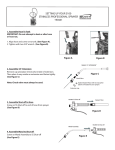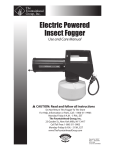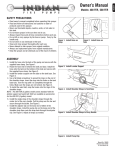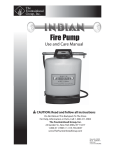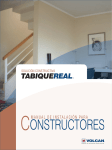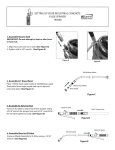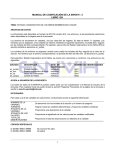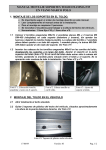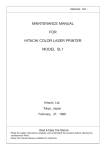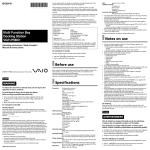Download D.B. Smith Professional Series Sprayers
Transcript
D.B. Smith Professional Series Sprayers Use and Care Manual (“O” Style) (“R” Style) CAUTION: Read and follow all instructions Do Not Return This Sprayer To The Store For Help, Information or Parts, Call : 1-800-311-9903 The Fountainhead Group, Inc. 23 Garden St., New York Mills, NY 13417 1-800-311-9903 www.TheFountainheadGroup.com Manual No. 181959 Rev B. 1/8/13 ECN13-001 5 1/2” x 8 1/2” Booklet SAFETY PRECAUTIONS • Read owner’s manual completely before operating this sprayer. • Always use goggles, gloves, and protective clothing when using sprayer. • Read and follow all instructions and cautions on label of products used in this sprayer. • Never use flammable liquids, caustics, acids, or hot water in this tank. • Do not leave sprayer in the sun when not in use. • Spray when air is calm to prevent drift of chemicals. • Do not use sprayer near open flame or anything that could cause ignition of the spray. • Always inspect hose and all hose connections before each use. A damaged hose, or loose hose connection can result in unintended exposure to the pressurized chemical, resulting in serious injury or property damage. • Do not lift or carry sprayer by the hose, shut-off valve, or extension. Carry by pump handle only, making sure handle is properly locked in place before lifting. • Do not pressurize with any mechanical device such as an air compressor, since this can create a dangerous pressure level and bursting of parts resulting in serious injury. Only use original pump. • Do not store chemicals in this tank. • Always release pressure when sprayer is not in use and before removing pump from tank. • Do not stand with face or body over top of tank when pumping or loosening pump, to prevent pump or solution from striking you, resulting in serious injury. • Clean and rinse sprayer thoroughly after each use. • Never attempt to alter sprayer from original condition. • Always use replacement parts from original manufacturer. • Keep the sprayer and all chemicals out of the reach of children. WARNING ALWAYS CLEAN THE SPRAYER AND SHUT-OFF THOROUGHLY AFTER EACH USE OR WHEN CHANGING APPLICATIONS AS DESCRIBED IN THE CLEANING SECTION. FAILURE TO COMPLETELY CLEAN MAY CAUSE CROSS-CONTAMINATION. CAUTION Always empty, clean and dry tank, pump system, shut-off, hose, and extension after each use. FAILURE TO DO SO MAY WEAKEN SPRAYER COMPONENTS, CAUSING COMPONENTS TO RUPTURE WHEN PRESSURIZED. Additionally, FAILURE TO CLEAN AND PROPERLY MAINTAIN YOUR SPRAYER WILL VOID MANUFACTURER’S WARRANTY. WARNING The sprayer is operated with liquid under pressure. Failure to observe caution and to follow instructions for operating and cleaning can cause tank, hose and other parts to be weakened and rupture under pressure. This can result in serious injury from high pressure discharge of liquids or forcible ejection of parts. Do not use flammable materials in this sprayer. Material could ignite or explode, causing serious injury and/or possible death. For safe use of this product, you must read and follow all instructions before use. TEST SPRAYER WITH WATER BEFORE USING ANY CHEMICALS. Do not return sprayer to store, if you experience problems or have questions contact our toll free Customer Service Center, M-F 8A.M. - 5P.M., EST, at 1-800-311-9903, or e-mail: [email protected], or access online at: www.TheFountainheadGroup.com. Page 2 ASSEMBLY INSTRUCTIONS Assemble Hose To Tank IMPORTANT: Do not attempt to heat or alter hose, hose nut, or barb prior to assembly. 1. Align hose barb tabs, push hose barb into tank until it stops (See Figure A). 2. Slide hose nut into place and turn clockwise to tighten. (See Figure B). NOTE: Do not use tools to tighten hose nut. Figure A Assemble Extension, Shut-Off & Nozzle 1. Install the extension onto the shut-off assembly and tighten the nut securely. (See Figure C) 2. Install selected nozzle onto the end of the extension and tighten securely. (See Figure D) SELECT USING NOZZLE CHART BELOW (Nozzle selections vary by model) D A E C G B F H A. Cap Nut B. Foaming Nozzle C. Adjustable Cone Nozzle D. Red High-Volume Fan Nozzle E. Yellow Low-Volume Fan Nozzle F. Flat Seal G. Adapter H. Extension Figure C ADJUSTABLE CONE USES: Spot spraying in or around flower beds, trees, and shrubs. Edging along fences, driveways, and walkways. Killing brush such as poison ivy, poison oak, kudzu and wild blackberry. Preparing garden beds for planting of ornamentals and vegetables. RED HIGH VOLUME FAN NOZZLE USES: Lawn replacement. Kill lawn and weeds before planting a new lawn. Preparing large areas for planting of ornamental and vegetable gardens. Figure B Figure D FOAMING NOZZLE USES: Spot spraying in flower beds, walkways, driveways, and patios, around trees and shrubs. Edging along fences, driveways and walkways. Killing brush such as poison ivy, poison oak, kudzu and wild blackberry. YELLOW LOW VOLUME FAN NOZZLE USES: For precision spraying in confined areas such as gardens and flower beds. Page 3 OPERATING INSTRUCTIONS Filling IMPORTANT: Always make sure the pressure is released from the tank before filling or servicing. If equipped, pull up on the knob of the pressure release valve until all the pressure is released from the tank. Otherwise, squeeze and hold shut-off lever until the unit stops spraying. Then, and only then, it is safe to remove pump. 1. Turn the pump handle counterclockwise to remove the pump (See Figure E). 2. Fill the tank to the desired level. See fill markings on side of tank. (Always refer to chemical manufacturer for proper mixture). 3. Install the pump into the tank opening and turn clockwise until tightly sealed against the tank (See Figure F). Figure E Figure F Pressurizing 1. Make sure shut-off lock is not engaged. (If shut-off lock is engaged while pressurizing, the unit will immediately start spraying). 2. Push down on the handle and turn counterclockwise to unlock the handle (See Figure G-1G). 3. Pressurize the sprayer by pumping the handle in a smooth up and down motion (See Figure G-2G). 4. Push down on the handle and turn clockwise to lock the handle into the pump (See Figure G-3G). 1G 2G 3G Figure G Spraying and Locking LEVER 1. Direct nozzle away from you and squeeze shut-off lever to begin spraying. 2. For continuous spraying, squeeze lever and rotate lock (See Figure H). 3. Unlock if needed and release shut-off lever to stop spraying. 4. Turn the nozzle tip to adjust the spray pattern. Release Tank Pressure Figure H Pressure Release Valve (PRV) on select models 1. NO PRV: Lay the tank on its side with the hose outlet on the bottom. Direct the nozzle away from you and squeeze the shut-off lever until the unit stops spraying. (See Figure I) 2. WITH PRV: Pull up on the knob of the PRV until all pressure is released from the tank. (See Figure J) Figure I Figure J Page 4 OPERATING INSTRUCTIONS CONTINUED Finish 1. Depressurize the tank as described in Release Tank Pressure section. 2. Turn the pump handle counterclockwise to remove the pump. 3. Empty any remaining liquid according to the product disposal directions. 4. Follow the Cleaning instructions. Cleaning 1. Remove the pump as described in the Finish section. 2. Fill the tank with cool, clean tap water. Replace the pump and tighten securely. 3. Agitate the tank to rinse the chemical from the tank wall and pump. 4. Remove the pump and empty the contents into gravel or bare soil. 5. Refill the tank with cool, clean tap water. 6. Make sure the pump is free of dirt or debris and reinstall into the tank. Tighten securely. 7. Pressurize the tank as described in the Pressurizing section. 8. Direct the nozzle away from you and activate the shut-off for at least 30 seconds to clean the hose and shut-off. 9. Release pressure as described in the Release Tank Pressure section. 10. Remove the pump and empty the contents into gravel or bare soil. 11. Repeat steps 5 - 10 until thoroughly cleaned. Sprayer Storage 1. Sprayer tank should be hung upside down, with the pump removed. 2. Do not store or leave any solution in the tank after use. 3. Store in a warm, dry location out of direct sunlight. 4. Keep the sprayer and all chemicals out of the reach of children. MAINTENANCE Pump Lubrication Pump should be periodically oiled by applying 10 to 12 drops of light oil down the pump rod through the opening in the pump cap as shown. “O” Style Pump Disassembly & Reassembly “R” Style NOTE: Remove pump from tank prior to disassembly. As shown on varying models. “O” Style 1. Inspect gasket. If worn or damaged, remove and replace. (See Figure 1) 2. To disassemble pump cap from pump barrel, squeeze the tabs (See Figure 2) that lock the barrel to the cap, and while resting the extension clip on a table or bench turn the barrel counterclockwise to unlock. (See Figure 3) Figure 1 Figure 2 Figure 3 Page 5 MAINTENANCE CONTINUED 3. Inspect o-ring. If worn or damaged, remove and replace. Lubricate o-ring with petroleum jelly. (See Figure 4) 4. Inspect check valve in bottom of barrel. If worn or damaged, remove and replace by pressing into hole in bottom of barrel. (See Figure 5) 5. Re-install the barrel into the cap. While holding the cap securely, turn the barrel clockwise to lock the tabs in place. Figure 4 Figure 5 “R” Style 1. Inspect gasket. If worn or damaged, remove and replace. (See Figure 6) 2. To remove pump cap from pump barrel, remove screws securing pump cap to barrel. (See Figure 7) Figure 6 Figure 7 3. Inspect o-ring. If worn or damaged, remove and replace. Lubricate o-ring with petroleum jelly. (See Figure 8) 4. Inspect check valve in bottom of barrel. If worn or damaged, remove and replace by pressing into hole in bottom of barrel. (See Figure 9) 5. Insert the pump handle assembly into the barrel. Align the holes in the pump cap and barrel. Reinstall screws and tighten securely. Figure 8 Figure 9 Nozzle Maintenance 1. If nozzle clogs, remove and disassemble the nozzle assembly. 2. Clean the openings of any obstructions and reassemble. Page 6 Shut-off Maintenance (Smith Pro II) Always depressurize sprayer before maintenance by activating shut-off and spraying contents out. 1. Unscrew the handle from the shut-off assembly. 2. Remove the filter from the shut-off assembly. 3. Clean any debris from inside the handle, shut-off assembly, or the filter by rinsing with cool, clean water. 4. Reassemble the components as shown and tighten all connections securely. C A B A. Handle B. Filter C. Shut-off Assembly TROUBLESHOOTING TROUBLE LOOK FOR REMEDY Sprayer starts to spray when pumping or sprayer will not stop spraying when shut-off lever is released. Shut-off lock is engaged. Squeeze shut-off lever and rotate the lock towards the nozzle as described in Spraying and Locking section. Sprayer leaks at pump or sprayer does not build pressure. 1. Dirt or debris on pump gasket (#2F, #5G, or #6B) or closure. 2. Chipped, torn, swollen, or defective pump gasket (#2F, #5G, or #6B). 3. Check valve (#2G, #5H, or #6A) at bottom of pump assembly. 4. Worn or damaged o-ring (#2D or #6C) on piston. 1. Clean dirt or debris from gasket (#2F, #5G, or #6B) or closure. 2. Remove old gasket (#2F, #5G, or #6B) and replace with new as described in Pump Disassembly & Reassembly section. 3. Replace if missing or damaged as described in Pump Disassembly & Reassembly section. 4. Replace if worn or damaged as described in Pump Disassembly & Reassembly section. Sprayer material overflows through pump barrel or pump handle rises when handle is unlocked. 1. Dirt or debris under check valve (#2G, #5H, or 6A) on pump. 2. Chipped, torn, or swollen pump check valve (#2G, #5H, or #6A). 1. Clean check valve (#2G, #5H, or 6A) and valve sealing surface on pump. 2. Replace check valve (#2G, #5H, or #6A) as described in Pump Disassembly & Reassembly section. Hose leaks at tank or shut-off. 1. Loose hose. 2. Cracked, swollen, or faulty hose. 1. Tighten hose nut. 2. Replace shut-off assembly. Sprayer is difficult to pump. 1. Damaged piston o-ring (#2D or #6C). 2. Piston o-ring (#2D or #6C) is dry. 1. Replace piston o-ring as described in Pump Disassembly & Reassembly section. 2. Lubricate piston o-ring as described in Pump Disassembly & Reassembly section. Sprayer tank leaks. Evidence of spray material escaping from the tank. Replace entire sprayer. Nozzle drips when shut-off lever is released. 1. Dirt or debris in shut-off valve. 2. Damaged o-ring or seal in shut-off (kit #11). 1. Clean shut-off as described in Shut-off Maintenance section. 2. Service shut-off seals as described in Maintenance service kit #11. Nozzle tip leaks, poor spray pattern, partial spray or complete stoppage. 1. Flat seal is missing or damaged. 2. Spray extension or nozzle clogged. 1. Replace flat seal at extension tip (kit #11). 2. Remove nozzle and clean as described in Nozzle Maintenance section. Page 7 KITS, PARTS & ACCESSORIES 9B 9A 8-1 8-2 11D 7-18 7-14 KIT #10 9C 9D KIT #9 8-3 11B 11C 9E 10C 10E 10A 10F 9F 10D KIT #11 11A 10B 11E 11A 11B KIT #6 6A 11C 7-SS 7-21 11E 6C 6B 11G 11F 11F 11D KIT #5 KIT #2 2B 5A 5B 2A 5C 2C 5D 2D 5E 6C 5F 2E 5G 2F 2G 5H 4 1-1 “O” 1-2 1-3 “R” 3-2 3-3 Page 8 “O” SPRAYER PARTS KEY# 1 -1 -2 -3 PART# DESCRIPTION KEY# PART# DESCRIPTION 181052 181036 181120 -2 3 -3 4 181828 181837 180836 1 GALLON “O” TANK 2 GALLON “O” TANK 3 GALLON “O” TANK 178040 180279 180278 180429 178041 178039V 171015V 2 GALLON “R” TANK (INCLUDES KEY #4) 3 GALLON “R” TANK (INCLUDES KEY #4) PRV ASSEMBLY KIT #5 181911 “R” PUMP KIT #2 180398 “O” PUMP 2A 2B 2C 2D 2E 2F 2G “R” SPRAYER PARTS “O” PUMP CAP “O” PUMP HANDLE “O” PUMP ROD “O” PUMP PISTON ASSEMBLY “O” PUMP BARREL “O” PUMP GASKET, VITON CHECK VALVE, VITON 5A 5B 5C 5D 5E 181830 182129 171002 181835 181834 “R” PUMP HANDLE “R” PUMP SCREW (2) “R” PUMP COVER “R” PUMP ROD “R” PUMP PISTON ASSEMBLY 5F 5G 5H 171003 “R” PUMP BARREL 181203 “R” PUMP GASKET 171015V CHECK VALVE, VITON KIT #6 182046 “R” PUMP SERVICE KIT 6A 6B 6C 171015V CHECK VALVE, VITON 181203 “R” PUMP GASKET 180861 “R” PUMP PISTON O-RING SMITH PRO II SHUT-OFF PARTS KEY# PART# DESCRIPTION -14 181845 -18 181843 7 -21 181824 -SS 182112 -1 8 -2 -3 181817 181818 181819 14” EXTENSION ASSEMBLY, SMITH PRO II 18” EXTENSION ASSEMBLY, SMITH PRO II 21” EXTENSION ASSEMBLY, SMITH PRO II 21” EXTENSION ASSEMBLY, STAINLESS STEEL, SMITH PRO II SHUT-OFF ASSEMBLY, SMITH PRO II, 1 GAL SHUT-OFF ASSEMBLY, SMITH PRO II, 2 GAL SHUT-OFF ASSEMBLY, SMITH PRO II, 3 GAL KIT #11 181910 SMITH PRO II SHUT-OFF SERVICE KIT 11A 11B 11C 11D 11E 11F 11G 181493 181840 181231 181468 181812 181810 181805 VALVE BODY O-RING POPPET SEAL BARB O-RING FILTER FLAT NOZZLE SEAL (2) WAND O-RING ADJUSTABLE NOZZLE O-RING KIT #9 181869 POLY NOZZLE KIT 9A 9B 9C 9D 9E 9F 181822 180168 180097 180266 181812 181804 POLY ADJUSTABLE NOZZLE YELLOW FLAT FAN NOZZLE (LOW VOLUME) RED FLAT FAN NOZZLE (HIGH VOLUME) FOAMING NOZZLE FLAT NOZZLE SEAL NOZZLE CAP NUT KIT #10 181870 BRASS NOZZLE KIT 10A 10B 10C 10D 10E 10F 181823 180168 180097 180266 181812 181804 BRASS ADJUSTABLE NOZZLE YELLOW FLAT FAN NOZZLE (LOW VOLUME) RED FLAT FAN NOZZLE (HIGH VOLUME) FOAMING NOZZLE FLAT NOZZLE SEAL NOZZLE CAP NUT Page 9 SERVICE KITS, PARTS & ACCESSORIES ARE AVAILABLE BY CONTACTING The Fountainhead Group, Inc. - Customer Service Center Monday - Friday 8 A.M. - 5 P.M., EST Toll Free: 1-800-311-9903 or e-mail: [email protected] or Access online at: www.TheFountainheadGroup.com Page 10 D.B. Atomizadores de la Serie Profesional Smith Manual de uso y cuidado (Estilo “O”) (Estilo “R” ) PRECAUCIÓN: Lea y siga todos las instrucciones No devuelva este atomizador a la tienda Para obtener ayuda, información o piezas, llame al: 1-800-311-9903 The Fountainhead Group, Inc. 23 Garden St., New York Mills, NY 13417 1-800-311-9903 www.TheFountainheadGroup.com Manual No. 181959 Rev B. 1/8/13 ECN13-001 PRECAUCIONES DE SEGURIDAD • Lea todo el manual del usuario antes de operar este atomizador. • Siempre utilice gafas de seguridad, guantes y ropa protectora cuando use el atomizador. • Lea y siga todas las instrucciones y precauciones que se muestran en la etiqueta de los productos que se usan en este atomizador. • Nunca utilice líquidos inflamables, agentes cáusticos, ácidos o agua caliente en este tanque. • No deje el atomizador expuesto al sol cuando no esté en uso. • Utilice el atomizador cuando no haya viento para evitar el desplazamiento de sustancias químicas. • No use el atomizador cerca de llamas o agentes que pudieran ocasionar que se encienda la solución de rociado. • Siempre revise la manguera y todas las conexiones de la misma antes de cada uso. Una manguera dañada o una con exión suelta pueden ocasionar una exposición no deseada a la sustancia química presurizada, lo cual podría provocar lesiones graves o daños a la propiedad. • No levante ni transporte el atomizador por la manguera, la válvula de cierre o extensión. Cargue la bomba por el mango solamente, cerciorándose de que el mango esté debidamente enganchado en posición antes de levantar. • No presurice con ningún dispositivo mecánico, como un compresor de aire, ya que puede generar niveles de presión peligrosos y algunas piezas podrían estallar, lo cual ocasionaría lesiones graves. Sólo use la bomba original. • No almacene sustancias químicas en este tanque. • Siempre alivie la presión cuando el rociador no está en uso y antes de quitar la bomba del tanque. • No se pare con lacara o el cuerpo sobre la parte superior del tanque cuando bombea o afloja la bomba, para evitar que la bomba o la solución le haga contacto con su querpo, resultando en lesión grave. • Limpie y enjuague el atomizador completamente después de cada uso. • Nunca intente modificar la condición original del atomizador. • Siempre utilice las piezas de reemplazo del fabricante original. • Mantenga el atomizador y todas las sustancias químicas fuera del alcance de los niños. ADVERTENCIA SIEMPRE LIMPIE EL ROCIADOR Y CIERRELO BIEN DESPUÉS DE CADA USO O CUANDO CAMBIE LAS APLICACIONES COMO SE DESCRIBE EN LA SECCIÓN LIMPIEZA. EL NO CUMPLIR CON LIMPIAR COMPLETAMENTE EL ROCIADOR PODRÍA PROVOCAR CONTAMINACIÓN CRUZADA. PRECAUCIÓN: Siempre vacíe, limpie y seque el tanque, el sistema de bomba, cierre, manguera y extensión después de cada uso. Si no lo hace, los componentes del atomizador podrían deteriorarse y romperse cuando estén presurizados. Si no limpia el atomizador y no le da un mantenimiento adecuado, se cancelará la garantía del fabricante. ADVERTENCIA El atomizador funciona con líquido a presión. Si no lo maneja con cuidado o no sigue las instrucciones de operación y limpieza, podría ocasionar el deterioro o la ruptura del tanque, manguera y otras piezas que están bajo presión. Esto puede provocar lesiones graves debido a la descarga de líquidos a alta presión o a la expulsión forzada de las piezas. No use materiales inflamables en este atomizador. El material podría encenderse o explotar y provocar lesiones graves y/o muerte. Para usar este producto de manera segura, debe leer y seguir todas las instrucciones antes de usarlo. PRUEBE EL ATOMIZADOR CON AGUA ANTES DE USAR SUSTANCIAS QUÍMICAS. No devuelva el atomizador a la tienda, si tiene problemas o preguntas, comuníquese con nuestro Centro de servicio al cliente llamando a la línea gratuita 1-800-311-9903, de lunes a viernes de 8 A.M. a 5 P.M., hora del este, escribiendo por correo electrónico a: [email protected] o accediendo en línea a: www.TheFountainheadGroup.com. página 12 INSTRUCCIONES DEL ENSAMBLAJE Ensamble la manguera en el tanque IMPORTANTE: No intente calentar ni alterar la manguera, tuerca de manguera o conector dentado antes del ensamblado. 1. Alinee las lengüetas de la espiga de la manguera, presione la espiga de la manguera en el tanque hasta que se detenga. (Vea la Figura A). 2. Deslice la tuerca de la manguera hasta su lugar y gire en sentido horario para ajustar. (Vea la Figura B). Figura A Figura B NOTA: No utilice herramientas para ajustar la tuerca de la manguera. Ensamblado de la extensión, el cierre y la boquilla 1. Instale la extensión en el dispositivo de cierre y ajuste la tuerca hasta que esté segura. (Vea la Figura C) 2. Instale la boquilla seleccionada en el extremo de la extensión y apriete hasta que esté segura. (Vea la Figura D) Figura C Figura D SELECCIONE UTILIZANDO LA TABLA DE BOQUILLAS QUE SE MUESTRA A CONTINUACIÓN. (Las selecciones de boquilla varían por modelo) Usos de las boquillas cono ajustables: Usos de las boquillas espumantes: D A E C G B F H Rociado localizado en o alrededor de arriates, árboles o arbustos. Bordes a lo largo de cercas, entradas y caminos. Destrucción de malezas, por ejemplo, hiedra venenosa, roble venenosa, kudzu y zarzamora silvestre Preparación de arriates de jardín para sembrar plantas ornamentales y vegetales. A. Tuerca ciega B. Boquilla para espuma C. Boquilla de cono adjustable D. Boquilla roja con ventilador para alto volumen E. Boquilla amarilla con ventilador para bajo volumen F. Sello plano G. Adaptador H. Extensión Rociado localizado de arriates, caminos, entradas y patios, alrededor de árboles y arbustos. Bordes a lo largo de cercas, entradas y caminos. Destrucción de malezas, por ejemplo, hiedra venenosa, roble venenoso, kudzu y zarzamora silvestre. Usos de las boquillas roja con Usos de las boquillas amarilla con ventilador para alto volumen: ventilador para bajo volumen: Reemplazo de césped. Mate el césped y las malezas antes de sembrar el césped nuevo. Preparación de áreas grandes para el sembrado de plantas ornamentales y vegetales. Para un rocío de precisión en zonas confinadas tales como jardines y maceteros. página 13 INSTRUCCIONES DE OPERACIÓN Llenado IMPORTANTE: Siempre asegúrese de que se ha liberado la presión del tanque antes de llenar o utilizar. Si provista, jale hacia arriba la perilla de la válvula de liberación de presión hasta que se libere toda la presión del tanque. De lo contrario, apriete y sostenga la palanca de la válvula de cierre hasta que la unidad deje de rociar. Después, y solamente después, es seguro quitar la bomba. 1. Gire el mango de la bomba en sentido antihorario para quitar la bomba (Vea la Figura E). 2. Llene el tanque al nivel deseado. Ver llenan señales en el lado del tanque. (Consulte siempre las intrucciones del fabricante del producto química para la mezcla apropiada). 3. Coloque la bomba en el orificio del tanque y gírela en sentido horario hasta ajustarla frimemente al tanque. (Vea la Figura F). Figura E Figura F Presurización 1. Asegúrese de que el seguro del mango de cierre no esté trabado (si el seguro del mango de cierre está trabado durante la presurización, la unidad comenzará a rociar de immediato. 2. Empuje hacia abajo el mango y gírelo en sentido antihorario para destrabar el mango (Vea la Figura G-1G). 3. Presurice el atomizador, bombeando el mango con un movimiento uniforme hacia arriba y hacia abajo. (Vea la Figura G-2G). 4. Empuje el mango hacia abajo y gírelo en sentido horario para trabar el mango en la bomba (Vea la Figura G-3G) 1G 2G 3G Figura G Atomizar y asegurar PALANCA 1. Dirija la boquilla lejos de usted y presione la palanca de cierre para empezar a atomizar. 2. Para atomizar de forma continua, presione la palanca y gire el seguro. (Vea la Figura H) 3. Retire el seguro si es necesario y suelte la palanca del dispositivo de cierre para dejar de atomizar. 4. Gire la punta de la boquilla para ajustar el patrón del rociado. Figura H Libere la presión del tanque Válvula de liberación de presión (PRV) en modelos seleccionados 1. SIN PRV: Coloque el tanque de costado con la salida de la manguera en la parte inferior. Dirija la boquilla en sentido contrario a usted y presione la palanca de cierre hasta que la unidad deje de rociar. (Vea la Figura I) 2. CON PRV: Jale hacia arriba la perilla de la válvula de liberación de presión hasta que toda la presión del tanque se haya liberado. (Vea la Figura J) Figura I Figura J página 14 INSTRUCCIONES DE OPERACIÓN (continuación) Finalización 1. Despresurice el tanque según se describe en la sección Libere la presión del tanque. 2. Gire el mango de la bomba en sentido antihorario para quitar la bomba. 3. Vacíe todo el líquido restante de acuerdo con las intrucciones de desecho del producto. 4. Siga las instrucciones de Limpieza. Limpieza 1. Quite la bomba según se describe en la sección Finalización. 2. Llene el tanque con agua de grifo fresca y limpia. Vuelva a colocar la bomba y ajústela firmemente. 3. Agite el tanque para quitar el producto químico de la pared del tanque y la bomba. 4. Quite la bomba y vacíe el contenido sobre gravilla o suelo descubierto. 5. Vuelva a llenar el tanque con agua de grifo fresca y limpia. 6. Asegúrese de que la bomba esté limpia y libre de residuos, y vuelva a instalarla en el tanque. Ajústela firmemente. 7. Presurice el tanque tal como se describe en la sección Presurización. 8. Dirija la boquilla lejos de usted y active el dispositivo de cierre durante por lo menos 30 segundos para limpiar la manguera y el dispositivo de cierre. 9. Libere la presión tal come se describe en la sección Libere la presión del tanque. 10. Quite la bomba y vacíe el contenido sobre gravilla o suelo descubierto. 11. Repita los pasos 5 a 10 hasta que la unidad esté completamente limpia. Alamacenamiento del atomizador 1. El tanque del atomizador debe colgarse en posición invertida y sin la bomba. 2. No almacene ni deje solución dentro del tanque después del uso. 3. Guárdelo en un lugar templado y seco, alejado de la luz solar directa. 4. Mantenga el atomizador y todos los productos químicos lejos del alcance de los niños. MANTENIMIENTO Lubricación de la bomba La bomba se debe aceitar periódicamente aplicando 10 ó 12 gotas de aceite liviano en la varilla de la bomba por la abertura de la tapa de la bomba como se muestra. Desensamblar y volver a ensamblar la bomba Estilo “O” Estilo “R” NOTA: Saque la bomba del tanque antes de desensamblar. Según se muestra en la variedad de modelos. Estilo “O” 1. Inspeccione la empaquetadura. Si está gastada o dañada, sáquela y reemplácela. (Vea la Figura 1) 2. Para desensamblar la tapa de la bomba o el cilindro de la bomba, apriete las trabillas (Vea la Figura 2) que traban el cilindro a la tapa, y mientras apoya el sujetador de extensión sobre una mesa o banco, gire el cilindro en sentido antihorario para destrabar.(Vea la Figura 3) Figura 1 Figura 2 Figura 3 página 15 MANTENIMIENTO (continuación) 3. Inspeccione la junta tórica. Si está gastada o dañada, sáquela y reemplácela. Lubrique la junta tórica con gel de petróleo. (Vea la Figura 4) 4. Inspeccione la válvula de retención en el fondo del cilindro. Si está gastada o dañada, sáquela y reemplácela presionando en el orificio en el fondo del cilindro. (Vea la Figura 5) 5. Reinstale el cilindro en la tapa. Mientras sujeta la tapa firmemente, gire el cilindro en sentido horario para fijar las trabillas en su lugar. Figura 4 Figura 5 Estilo “R” 1. Inspeccione la empaquetadura. Si está gastada o dañada, sáquela y reemplácela. (Vea la Figura 6) 2. Para sacar la tapa de la bomba del cilindro de la bomba, retire los tornillos que aseguran la tapa de la bomba al tubo. (Vea la Figura 7) Figura 6 Figura 7 3. Inspeccione la junta tórica. Si está gastada o dañada, sáquela y reemplácela. Lubrique la junta tórica con gel de petróleo. (Vea la Figura 8) 4. Inspeccione la válvula de retención en el fondo del cilindro. Si está gastada o dañada, sáquela y reemplácela presionando en el orificio en el fondo del cilindro. (Vea la Figura 9) 5. Inserte el ensamblado del mango de la bomba en el cilindro de la bomba. Alinee los orificios de la tapa de la bomba y el cilindro. Coloque nuevamente los tornillos y ajústelos firmemente. Figura 8 Figura 9 Mantenimiento de la boquilla 1. Si la boquilla se atasca, retírela y desarme el ensamblaje de la boquilla. 2. Retire todas las obstrucciones presentes en las aberturas y vuelva a ensamblar página 16 Mantenimiento del dispositivo de cierre (Smith Pro) Siempre despresurice el atomizador antes de darle mantenimiento al activar el cierre y atomizador los contenidos hacia afuera. A B 1. Destornille el mango del dispositvo de cierre. 2. Retire el filtro del dispositivo de cierre. 3. Limpie todo residuo presente en el interior del mango A. Mango y del despositivo de cierre o en el asiento de válvula filtro. B. Filtro C. Dispositivo de cierre 4. Vuelva a ensamblar los componentes según se muestra en la figura y apriete todas las conexiones hasta que queden aseguradas. C SOLUCIÓN DE PROBLEMAS PROBLEMA BUSCAR SOLUCIÓN El atomizador empieza a rociar al bombear o el atomizador no deja de rociar cuando el gatillo de cierre se libera. El seguro del dispositivo de cierre está activado. Presione la palanca de cierre y suelte el seguro. Vea la sección Atomizar y asegurar. El atomizador tiene una pérdida en la bomba o el atomizador no acumula presión. 1. Hay suciedad o residuos en la empaquetadura de la bomba (No.2F, No.5G o No.6B) o en el cierre. 2. Empaquetadura de bomba (No.2F, No.5G o No.6B) astillada, rasgada, dilatada o defectuosa. 3. Revise la válvula (No.2G, No.5H o No.6A) en la parte inferior del ensamblado de la bomba. 4. Junta tórica gastada o dañada (#2D ó #6C) sobre el pistón. 1. Limpie la suciedad o los residuos de la empaquetadura (No.2F, No.5G o No.6B) o el cierre. 2. Retire la empaquetadura (No.2F, No.5G o No.6B) y reemplácela con una nueva como se describe en la sección Desensamblar y volver a ensamblar la bomba. 3. Reemplace ante ausencia o daños como se describe en la sección Desensamblar y volver a ensamblar la bomba. 4. Reemplace si está gastada o dañadacomo se describe en la sección Desensamblar y volver a ensamblar la bomba. El material del atomizador se derrama por el cilindro de la bomba o el mango de la bomba se eleva cuando se lo destraba. 1. Suciedad o residuos debajo de la válvula de retención (No.2G, No.5H o No.6A) de la bomba. 2. Válvula de retención (No.2G, No.5H o No.6A) de bomba astillada rasgada o dilatada. 1. Limpie la válvula de retención (No.2G, No.5H o No.6A) y la superficie sellada de la válvula de la bomba. 2. Reemplace la válvula de retención (No.2G, No.5H o No.6A) como se describe en la sección Desensamblar y volver a ensamblar la bomba. La manguera tiene una pérdida en el tanque o en el dispositivo de cierre. 1. Manguera suelta. 2. Manguera agrietada, dilatada o defectuosa. 1. Ajuste la tuerca de manguera. 2. Reemplace el conjunto de cierre. Atomizador difícil de bombear. 1. La junta tórica del pistón (No.2D o No.6C) está dañada. 2. La junta tórica del pistón (No.2D o No.6C) está seca. 1. Reemplace la junta tórica del pistón come se describe en la sección Desensamblar y volver a ensamblar la bomba. 2. Lubrique la junta tórica del pistón como se describe en la sección Desensamblar y volver a ensamblar la bomba. El tanque del atomizador tiene una pérdida. Hay evidencia de escape del material de rociado del tanque. Reemplace todo el atomizador. La boquilla gotea cuando se suelta la palanca de la válvula de paso. 1. Suciedad o residuos en la válvula del dispositivo de cierre. 2. Junta tórica o sello dañado en el dispositivo de cierre (Kit No.11) 1. Limpie el dispositivo de cierre tal como se describe en la sección Mantenimiento del dispositivo de cierre. 2. Déle mantenimiento a los sellos de cierre tal como se describe en juego de mantenimiento No.11. La punta de la boquilla sechorrea, patrón de aspersión débil, aspersión parcial o bloqueo completo. 1. Falta el sello plano o está dañado. 2. La extensión de aspersión o la boquilla están bloqueadas. 1. Reemplace el sello plano en la punta de la extensión (juego No.11). 2. Retire la boquilla y limpie tal como se describe en la sección Mantenimiento de la boquilla. página 17 JUEGOS, PIEZAS Y ACCESORIOS 9B 9A 8-1 8-2 11D 7-21 7-18 7-14 KIT No.10 9C 9D KIT No.9 8-3 11B 11C 9E 10B 10C 10E 10A 10F 9F 10D KIT No.11 11A 11E 11A 11B 6A KIT #6 11C 7-SS 11E 6C 6B 11G 11F 11F 11D KIT No.5 KIT No.2 5A 2B 5B 2A 5C 5D 2C 5E 2D 6C 5F 2E 5G 2F 1-1 “O” 5H 4 2G 1-2 1-3 “R” 3-2 3-3 página 18 PARTES DEL ATOMIZADOR “O” No. DE No. DE DESCRIPCIÓN CLAVE PIEZA 1 -1 -2 -3 181052 181036 181120 TANQUE “O” DE 1 GALÓN TANQUE “O” DE 2 GALONES TANQUE “O” DE 3 GALONES KIT No.2 180398 LA BOMBA “O” 2A 2B 2C 178040 180279 180278 TAPA “O” DE LA BOMBA MANGO “O” DE LA BOMBA VARILLA “O” DE LA BOMBA ENSAMBLADO DEL PISTÓN “O” DE LA 180429 BOMBA 178041 CILINDRO “O” DE LA BOMBA EMPAQUETADURA “O” DE LA BOMBA, 178039V VITON 171015V VÁLVULA DE RETENCIÓN, VITON 2D 2E 2F 2G PARTES DEL ATOMIZADOR “R” No. DE No. DE DESCRIPCIÓN CLAVE PIEZA -2 3 -3 4 TANQUE “R” DE 1 GALÓN (INCLUYE CLAVE NO.4) TANQUE “R” DE 2 GALONES (INCLUYE 181837 CLAVE NO.4) 180836 ENSAMBLAJE DEL PRV 181828 KIT No.5 181911 LA BOMBA “R” 5A 5B 5C 5D 5E 5F 5G 5H 181830 182129 171002 181835 MANGO “R” DE LA BOMBA TORNILLO “R” DE LA BOMBA (2) CUBIERTA “R” DE LA BOMBA VARILLA “R” DE LA BOMBA ENSAMBLADO DEL PISTÓN “R” DE LA 181834 BOMBA 171003 CILINDRO “O” DE LA BOMBA 181203 EMPAQUETADURA “R” DE LA BOMBA 171015V VÁLVULA DE RETENCIÓN KIT No.6 182046 JUEGO DE MANTENIMIENTO DE BOMBA “R” 6A 6B 6C 171015V VÁLVULA DE RETENCIÓN 181203 EMPAQUETADURA “R” DE LA BOMBA ANILLO “O” DEL PISTÓN “R” DE LA 180861 BOMBA PIEZAS DE CIERRE SMITH PRO II No. DE No. DE DESCRIPCIÓN CLAVE PIEZA -14 181845 -18 181843 7 -21 181824 -SS 182112 8 -1 181817 -2 181818 -3 181819 ENSAMBLADO DE LA EXTENSIÓN DE 14”, SMITH PRO II ENSAMBLADO DE LA EXTENSIÓN DE 18”, SMITH PRO II ENSAMBLADO DE LA EXTENSIÓN DE 21”, SMITH PRO II ENSAMBLADO DE LA EXTENSIÓN DE 21”, ACERO INOXIDABLE, SMITH PRO II ENSAMBLADO DEL CIERRE SMITH PRO II, 1 GALÓN ENSAMBLADO DEL CIERRE SMITH PRO II, 2 GALONES ENSAMBLADO DEL CIERRE SMITH PRO II, 3 GALONES KIT No.9 181869 JUEGO DE BOQUILLA DE POLICARBONATO 9A 9D 9E 181822 BOQUILLA DE POLICARBONATO AJUSTABLE BOQUILLA AMARILLA DE VENTILADOR PLANO 180168 (BAJO VOLUMEN) BOQUILLA ROJA DE VENTILADOR PLANO 180097 (ALTO VOLUMEN) 180266 BOQUILLA PARA ESPUMA 181812 SELLO DE BOQUILLA PLANA 9F 181804 TUERCA CIEGA DE BOQUILLA 9B 9C KIT No.10 181870 JUEGO DE BOQUILLA DE COBRE 10A 181823 10B 180168 10C 180097 10D 180266 10E 181812 10F 181804 BOQUILLA DE COBRE AJUSTABLE BOQUILLA AMARILLA DE VENTILADOR PLANO (BAJO VOLUMEN) BOQUILLA ROJA DE VENTILADOR PLANO (ALTO VOLUMEN) BOQUILLA PARA ESPUMA SELLO DE BOQUILLA PLANA TUERCA CIEGA DE BOQUILLA KIT No.11 181910 JUEGO DE MANTENIMIENTO DE DESPOSITIVO DE CIERRE SMITH PRO II 11A 11B 11C 11D 11E 11F 11G 181493 181840 181231 181468 181812 181810 181805 ANILLO “O” DEL CUERPO DE LA VÁLVULA SELLO DEL ASIENTO JUNTA TÓRICA DEL CONECTOR FILTRO SELLO DE BOQUILLA PLANA (2) ANILLO “O” DE VARILLA ANILLO “O” DE BOQUILLA AJUSTABLE página 19 LOS JUEGOS DE REPARACIÓN, PIEZAS Y ACCESORIOS SE ENCUENTRAN DISPONIBLES COMUNICÁNDOSE A The Fountainhead Group, Inc. - Centro deservicio al cliente De lunes a viernes de 8 A.M. a 5 P.M., EST Llame sin costo al: 1-800-311-9903 o Correo electrónico: [email protected] o Ingrese en línea a: www.TheFountainheadGroup.com página 20






















